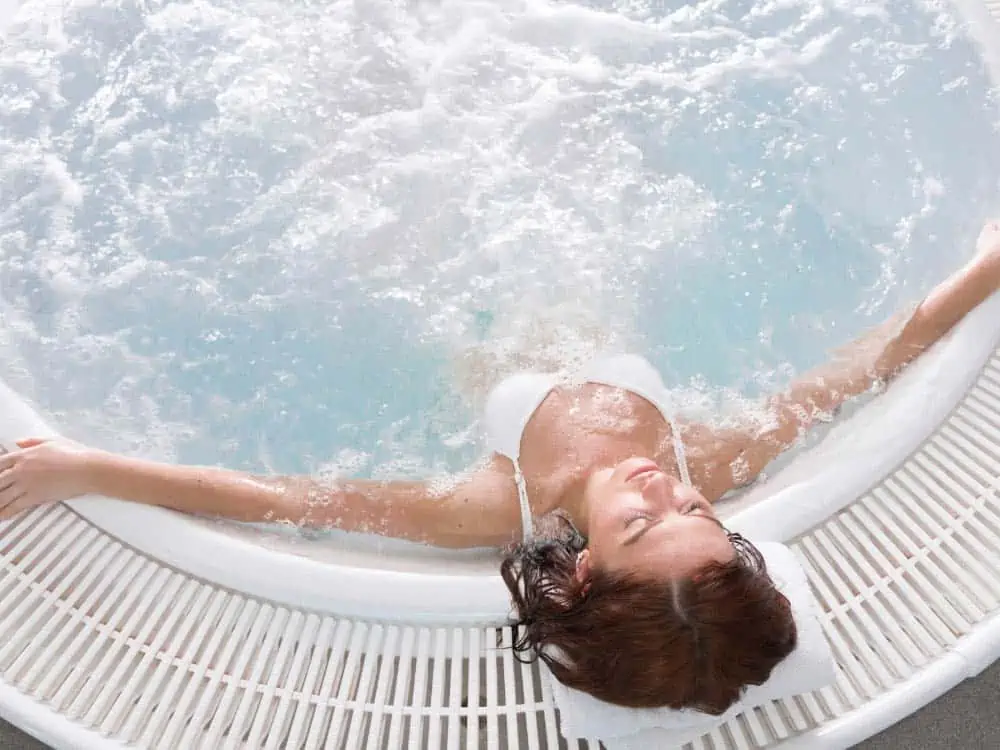We're sharing the amazing benefits of a morning hot tub soak.

Hot Tub After Surgery: 5 Benefits and 3 Steps to Getting Back in the Tub
How soon after surgery can you get back in your hot tub? Here are some quick answers:
- Don’t take a bath for 14 days after major surgery.
- Wait 4 weeks after surgery to get back in your hot tub.
That’s simple advice, but there is more to know about how to use a hot tub to aid your recovery. We’re going to show you 5 benefits of your hot tub for post-surgery recovery, specific guidelines on when you can safely soak, and a few simple steps to help you get in the tub and back to full health.
Let’s begin by exploring when and how you can safely use your hot tub after surgery.

When Can I Use a Hot Tub After Surgery?
One of the most common questions we hear is, “how long after surgery can you go in a hot tub?” The answer depends on the type of surgery and your healing progress. Generally, you should wait until your incision is fully healed to avoid infection or complications. Below, we outline specific timelines for common surgeries, but always consult your doctor for personalized advice.
Hot Tub After Laparoscopic Surgery
When can you go in a hot tub after laparoscopic surgery? Because laparoscopic procedures use small incisions, recovery is often quicker. You may be able to use a hot tub about 1-2 weeks after surgery, once stitches are removed or dissolvable stitches have sealed the wound. However, avoid soaking if there’s any redness or oozing, and wait longer for lake or public hot tubs due to higher infection risks.
Hot Tub After Hip Replacement
For those wondering when they can get in a hot tub after hip replacement, patience is key. Hip replacement surgery requires significant healing, and doctors typically recommend waiting 6-8 weeks before soaking in a hot tub. This ensures the incision is fully closed and reduces the risk of infection. Once cleared by your surgeon, a hot tub can aid rehabilitation by relaxing muscles and reducing joint stress.
Hot Tub After Open Heart Surgery
How long after open heart surgery can you go in a hot tub? Open heart surgery, such as bypass procedures, involves a longer recovery period. You should wait at least 6-8 weeks, and some doctors may advise up to 3 months to ensure the breastbone and incision are fully healed. Always get your surgeon’s approval, as hot water can affect blood pressure, which is a concern for heart patients.
Hot Tub After Vasectomy
Using a hot tub after a vasectomy requires caution due to the sensitive nature of the procedure. Generally, you should wait about 1-2 weeks, or until the incision is fully healed and any swelling has subsided. Soaking too soon could increase the risk of infection or irritation, so consult your doctor to confirm when it’s safe to enjoy your hot tub.
General Guidelines for Other Surgeries
For most major surgeries, such as appendectomies or hysterectomies, wait at least 4-6 weeks before using a hot tub, and ensure all stitches are removed or dissolved. How long after stitches can you go in a hot tub? Typically, you should wait until the wound is completely closed, which may take 2-4 weeks, depending on the surgery. Always err on the side of caution and check with your healthcare provider.
| Surgery Type | Typical Wait Time for Hot Tub Use | Key Considerations |
|---|---|---|
| Laparoscopic Surgery | 1-2 weeks | Ensure incision is healed; avoid public hot tubs. |
| Hip Replacement | 6-8 weeks | Confirm with surgeon; aids rehab once healed. |
| Open Heart Surgery | 6-12 weeks | Monitor blood pressure; get doctor’s approval. |
| Vasectomy | 1-2 weeks | Wait for swelling to subside; check for infection. |
| General Major Surgery | 4-6 weeks | Ensure stitches are removed; consult doctor. |
Precautions for Safe Hot Tub Use After Surgery
Using a hot tub after surgery can be incredibly beneficial, but it’s a delicate matter that requires careful consideration. To ensure a safe and effective experience, follow these precautions to protect your recovery and avoid complications.
- Wait Until Wounds Are Fully Healed: Never soak in a hot tub if your incision is still open or has stitches, as water can soften the wound and introduce bacteria, leading to infection. This is especially critical when asking, “how long after stitches can I go in a hot tub?” Always confirm the wound is fully closed with your doctor.
- Use Warm, Not Hot, Water: Extremely hot water can raise blood pressure or cause dizziness, particularly after surgeries like open heart surgery. Keep the temperature comfortable, around 98-100°F, and limit your soak to 15-20 minutes.
- Avoid Certain Medications: If you’re taking pain medications, avoid hot tubs, as they can interact with heat and cause drowsiness or other side effects. Check with your doctor before soaking.
- Be Cautious with Jets: For surgeries like hip replacement, avoid directing water jets at the surgical site, as this could cause discomfort or disrupt healing. Position yourself to relax without direct pressure on the area.
- Consult Your Surgeon: Every surgery and recovery is unique. Whether you’re recovering from a vasectomy or a hip replacement, your surgeon’s guidance is crucial to determine when you can safely use a hot tub.
Benefits of Hot Water
A hot soak is one of those things that you will always look forward to after a long and tiring day as it can be super-relaxing. But how does a hot tub work, and what are the health benefits of using one?
1. Can Help Your Body Fight Off Viruses
The steam that rises from the hot water when taking a soak can effectively relieve terrible coughs and clear out your stuffy nose.
The congestion in your nose is often because of inflammation along the nasal passages, and the steam will help loosen the blockage by getting into your blood vessels.
A hot bath can also help you fight off the virus that causes flu. The hot water does this by heating the body and improving your immune markers to allow certain types of immune cells to function better, making them more effective at fighting the virus.
2. The Warmth of the Water Helps Improve Circulation
The hot water in your tub helps open up blood vessels to allow your blood to flow easily, improving overall circulation. This also helps lower your blood pressure and reduces the stiffening of your blood vessels.
Besides improving circulation, a warm soak will also make your blood more oxygenated as it encourages you to take deep and slow breaths as the steam passes through your nasal passages. Jumping into a hot tub before bed will help you sleep better, thanks to the improved circulation.
3. Hot Baths Can Help You Lose Weight
Hot tub hydrotherapy can also aid in weight loss. Some studies conclude that being in hot water for just 1 hour is as effective for weight loss as taking a 30-minute walk as you will burn up to 140 calories.
The body faces external stress when you get into the hot water, which induces the production of heat shock proteins that are known to aid in calorie burning and weight loss.
Soaking in a hot tub also increases your energy expenditure significantly. Some studies put the increase in energy use at up to 80% when taking a 1 hour bath. The increased energy expenditure means you burn more calories, which is vital for weight loss.
4. Opens the Pores to Cleanse the Skin
The hot water will help open up your pores, which is highly useful for the skin’s general health. Opening up the pores allows for a deep cleanse of the skin so it can “breathe” much better.
A warm soak will remove the surface oils and other things that clog your pores, like dirt and makeup. Dead cells are also easier to remove with a warm bath. Therefore, your lotion and any other moisturizer can penetrate deep and be more effective at moisturizing your skin.
If you combine the warm water with spa salts and oils, you can ensure even better skin hydration and deal with skin irritations. Make sure the water temperature is not too high, as scalding baths can irritate the skin.
5. Relieves Muscle Pain

If you are having muscle pain after a long day or a workout, a warm soak can do you a lot of good as it is very effective at relieving muscle pain.
The heat from the water relaxes sore and tight muscles by getting your blood moving. You can make things even better by adding Epsom salt to the water.
Using salt has been proven to offer superior anti-inflammatory properties to help reduce inflammation caused by overexertion of muscles or even muscle diseases and other conditions like arthritis.
How Soon Can I Go Swimming After Surgery?
Generally, there should not be an issue if you go swimming several weeks after surgery. However, how soon you can go swimming after surgery depends on the specific procedure and how fast you recover.
For some types of surgery, the doctors will recommend that you wait for several months before getting into the water, while for others, a couple of weeks should be enough wait.
Here are some estimates for how long you must wait before swimming for some common surgeries.
1. Appendectomy
Appendectomy is a simple and minimally invasive surgery and the wound left is also relatively small, meaning you will not have to wait very long before you can swim. Once the stitches are removed and the wound has closed up well, you are free to swim, which should take anywhere between 2 and 3 weeks.
2. Laparoscopic Surgery
Laparoscopic surgery is a minimally invasive surgery that uses small incisions, reducing the recovery time significantly. You can be back to work in just a couple of weeks, and full recovery will take as little as one month.
It is safe to swim in just a couple of days, provided you do not overstrain, but you should wait at least 2 weeks to swim in lake water as there is a greater risk of infection.
3. Hip Replacement
It will take up to 3 months to fully recover from a hip replacement surgery, and many doctors will advise you to wait that long before swimming. However, you will still need to be gentle when swimming and avoid certain styles.
4. Knee Surgery
Although most people will recover from a knee replacement surgery in around 6 months, some can take up to 1 year. However, you will not need to wait that long before swimming. Some people will be okay enough to start swimming in around a month, but it is wise to talk to your doctor before you start swimming.
5. Heart Surgery
The healing time for a heart bypass surgery is 3 to 6 months. Therefore, you will have to wait for at least 3 months before swimming. The long wait time is crucial as it ensures the breast bone heals properly.
6. Plastic Surgery
Plastic surgery recovery will require proper aftercare for quick and proper healing like any other invasive medical procedure. You should keep the wounds infection-free and protect the skin from the excess force, meaning no diving or using water slides.
The plastic surgeon should advise you on how long you have to wait before swimming, but it will be safe to get into the water after 6 weeks for most procedures.
Issues Related with Having a Hot Bath After Surgery
While many people find it okay to get into a hot tub once they have enough strength after surgery, there are some issues you need to be aware of and take necessary caution.
- Improper Wound Healing & Infection
If the wound is not healed correctly, using a hot tub can cause the stitches to open up as water wets and softens the incision line. When your wound opens up, it can allow bacteria to enter the body and cause post-surgery infections.
Make sure you never get into a hot tub or swimming pool when you have an open wound or are bandaged. Also, avoid soaking in water if you have external fixation devices such as the metal frames used to hold bones in place.
- Use Caution Getting In and Out
Getting in and out of the tub can be strenuous, especially if it is raised from the ground. The process can lead to excess strain on your wound and cause post-surgery complications like the bandage that keeps the wound closed falling off before time.
There are also other risks associated with getting in and out of the tub, such as the danger of slipping. Remember that you still do not have all your strength back after surgery, so it is not worth the risk.
Some of the best hot tub brands will have some special tub types for post-surgery recovery that are designed for safe and easy use. Hence it is crucial to understand how to choose a hot tub for surgery recovery if you plan to use one.
- Increased Blood Pressure
Hot water can increase your blood pressure, which is dangerous if you have a heart condition. Therefore, it is vital to make sure you only use warm water during your soak to prevent blood pressure issues.
Using a Hot Tub After Surgery
There will be tons of time to use your hot tub once you fully recover, so you should not be in a hurry to plunge into the water. A hot tub is good for stress relief, but it will only be good for you if it does not cause further post-surgery complications.
It is essential to follow your doctor’s advice and only use the tub once healed adequately, as it will be even more beneficial.
Once your wound closes up, a hot tub will help you relax your tense muscles and warm up your core to improve circulation.
Conclusion
Hot tubs can be highly beneficial to your body and overall well-being, especially when recovering after surgery. Immersing your body in the water for a few minutes will relieve stress, uplift your mood, improve circulation, and relax muscles.
However, it is vital to ensure you get the timing right and only use the tub once your wounds have healed. Talking to your doctor is always the best way to know when you can start using a tub post-surgery.
Frequently Asked Questions
How long after surgery can I get in the hot tub?
The wait time varies by surgery. For minor procedures like laparoscopic surgery, you may wait 1-2 weeks. For major surgeries like hip replacement or open heart surgery, expect 6-8 weeks or more. Always consult your surgeon to ensure your incision is fully healed.
When can I go in a hot tub after laparoscopic surgery?
You can typically use a hot tub 1-2 weeks after laparoscopic surgery, provided the incision is healed and stitches are removed or dissolved. Avoid public hot tubs for at least 2 weeks to reduce infection risk.
When can I get in a hot tub after hip replacement?
Wait at least 6-8 weeks after hip replacement surgery, or until your surgeon confirms the incision is fully healed. Hot tubs can then help with muscle relaxation and joint mobility during recovery.
How long after open heart surgery can you go in a hot tub?
After open heart surgery, wait 6-12 weeks, depending on your surgeon’s advice. The breastbone and incision need time to heal, and hot water can affect blood pressure, so proceed with caution.
Can I use a hot tub after a vasectomy?
Yes, but wait 1-2 weeks after a vasectomy, or until swelling subsides and the incision is healed. Consult your doctor to avoid risks like infection or irritation from soaking too soon.

Have questions on using a hot tub after surgery? Request a Consultation!
Call us at 888-884-3742, visit our Durham or Raleigh Hot Tub store, or fill out the form below.
Richard Horvath
Richard has been in the hot tub & spa industry for years. As a long hot tub & swim spa owner himself, Richard has a passion for helping homeowners create their dream backyard.



